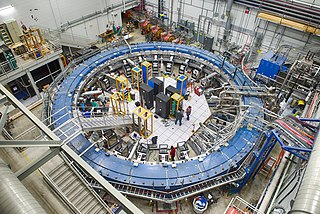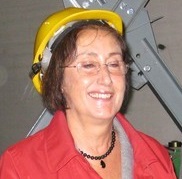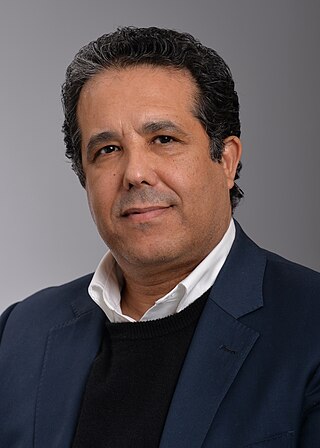The muon neutrino is an elementary particle which has the symbol
ν
μ and zero electric charge. Together with the muon it forms the second generation of leptons, hence the name muon neutrino. It was discovered in 1962 by Leon Lederman, Melvin Schwartz and Jack Steinberger. The discovery was rewarded with the 1988 Nobel Prize in Physics.

The Collider Detector at Fermilab (CDF) experimental collaboration studies high energy particle collisions from the Tevatron, the world's former highest-energy particle accelerator. The goal is to discover the identity and properties of the particles that make up the universe and to understand the forces and interactions between those particles.

Main injector neutrino oscillation search (MINOS) was a particle physics experiment designed to study the phenomena of neutrino oscillations, first discovered by a Super-Kamiokande (Super-K) experiment in 1998. Neutrinos produced by the NuMI beamline at Fermilab near Chicago are observed at two detectors, one very close to where the beam is produced, and another much larger detector 735 km away in northern Minnesota.
T2K is a particle physics experiment studying the oscillations of the accelerator neutrinos. The experiment is conducted in Japan by the international cooperation of about 500 physicists and engineers with over 60 research institutions from several countries from Europe, Asia and North America and it is a recognized CERN experiment (RE13). T2K collected data within its first phase of operation from 2010 till 2021. The second phase of data taking (T2K-II) is expected to start in 2023 and last until commencement of the successor of T2K – the Hyper-Kamiokande experiment in 2027.

Laboratori Nazionali del Gran Sasso (LNGS) is the largest underground research center in the world. Situated below Gran Sasso mountain in Italy, it is well known for particle physics research by the INFN. In addition to a surface portion of the laboratory, there are extensive underground facilities beneath the mountain. The nearest towns are L'Aquila and Teramo. The facility is located about 120 km from Rome.

The NOνA experiment is a particle physics experiment designed to detect neutrinos in Fermilab's NuMI beam. Intended to be the successor to MINOS, NOνA consists of two detectors, one at Fermilab, and one in northern Minnesota. Neutrinos from NuMI pass through 810 km of Earth to reach the far detector. NOνA's main goal is to observe the oscillation of muon neutrinos to electron neutrinos. The primary physics goals of NOvA are:
The timeline of particle physics lists the sequence of particle physics theories and discoveries in chronological order. The most modern developments follow the scientific development of the discipline of particle physics.

CDHS was a neutrino experiment at CERN taking data from 1976 until 1984. The experiment was officially referred to as WA1. CDHS was a collaboration of groups from CERN, Dortmund, Heidelberg, Saclay and later Warsaw. The collaboration was led by Jack Steinberger. The experiment was designed to study deep inelastic neutrino interactions in iron.
The Oscillation Project with Emulsion-tRacking Apparatus (OPERA) was an instrument used in a scientific experiment for detecting tau neutrinos from muon neutrino oscillations. The experiment is a collaboration between CERN in Geneva, Switzerland, and the Laboratori Nazionali del Gran Sasso (LNGS) in Gran Sasso, Italy and uses the CERN Neutrinos to Gran Sasso (CNGS) neutrino beam.

The CERN Neutrinos to Gran Sasso (CNGS) project was a physics project of the European Organization for Nuclear Research (CERN). The aim of the project was to analyse the hypothesis of neutrino oscillation by directing a beam of neutrinos from CERN's facilities to the detector of the OPERA experiment at the Gran Sasso National Laboratory (LNGS), located in the Gran Sasso mountain in Italy. The CNGS facility was housed in a tunnel which diverged from one of the SPS–LHC transfer tunnels, at the Franco–Swiss border near Geneva. It used the Super Proton Synchrotron (SPS) accelerator as a source of high-energy protons.

In 2011, the OPERA experiment mistakenly observed neutrinos appearing to travel faster than light. Even before the source of the error was discovered, the result was considered anomalous because speeds higher than that of light in vacuum are generally thought to violate special relativity, a cornerstone of the modern understanding of physics for over a century.
The Deep Underground Neutrino Experiment (DUNE) is a neutrino experiment under construction, with a near detector at Fermilab and a far detector at the Sanford Underground Research Facility that will observe neutrinos produced at Fermilab. An intense beam of trillions of neutrinos from the production facility at Fermilab will be sent over a distance of 1,300 kilometers (810 mi) with the goal of understanding the role of neutrinos in the universe. More than 1,000 collaborators work on the project. The experiment is designed for a 20-year period of data collection.
ICARUS is a physics experiment aimed at studying neutrinos. It was located at the Laboratori Nazionali del Gran Sasso (LNGS) where it started operations in 2010. After completion of its operations there, it was refurbished at CERN for re-use at Fermilab, in the same neutrino beam as the MiniBooNE, MicroBooNE and Short Baseline Near Detector (SBND) experiments. The ICARUS detector was then taken apart for transport and reassembled at Fermilab, where data collection is expected to begin in fall 2021.
Measurements of neutrino speed have been conducted as tests of special relativity and for the determination of the mass of neutrinos. Astronomical searches investigate whether light and neutrinos emitted simultaneously from a distant source are arriving simultaneously on Earth. Terrestrial searches include time of flight measurements using synchronized clocks, and direct comparison of neutrino speed with the speed of other particles.

Muon g − 2 is a particle physics experiment at Fermilab to measure the anomalous magnetic dipole moment of a muon to a precision of 0.14 ppm, which is a sensitive test of the Standard Model. It might also provide evidence of the existence of new particles.

FASER is one of the nine particle physics experiments in 2022 at the Large Hadron Collider at CERN. It is designed to both search for new light and weakly coupled elementary particles, and to detect and study the interactions of high-energy collider neutrinos. In 2023, FASER and SND@LHC reported the first observation of collider neutrinos.
An accelerator neutrino is a human-generated neutrino or antineutrino obtained using particle accelerators, in which beam of protons is accelerated and collided with a fixed target, producing mesons which then decay into neutrinos. Depending on the energy of the accelerated protons and whether mesons decay in flight or at rest it is possible to generate neutrinos of a different flavour, energy and angular distribution. Accelerator neutrinos are used to study neutrino interactions and neutrino oscillations taking advantage of high intensity of neutrino beams, as well as a possibility to control and understand their type and kinematic properties to a much greater extent than for neutrinos from other sources.
Karol Sylwester Lang is an experimental particle physicist and the Jane and Roland Blumberg Professor of Physics at the University of Texas at Austin.

Lucia Votano is an Italian astroparticle physicist, and the first woman to direct the Gran Sasso National Laboratory, from 2009 to 2012. Her research focuses on neutrinos, and she was the coordinator of the OPERA experiment, that led to the first detection of tau neutrinos from muon neutrino oscillation.

Kamal Benslama is a Moroccan-Swiss experimental particle physicist. He is a professor of physics at Drew University, a visiting experimental scientist at Fermilab, and a guest scientist at Brookhaven National Laboratory. He worked on the ATLAS experiment, at the Large Hadron Collider (LHC) at CERN in Switzerland, which is considered the largest experiment in the history of physical science. At present, he is member of the MU2E collaboration at Fermi National Accelerator Laboratory (Fermilab), located just outside Batavia, Illinois, near Chicago. Fermilab is a United States Department of Energy national laboratory specializing in high-energy particle physics.











